
Noisy Toys interviews:
Robert S. Hilton
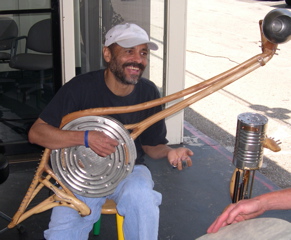 Robert S. Hilton’s “Incredible String Thing” |
Robert is a percussionist and teacher who creates and plays unusual instruments made from natural and “found” objects. Robert performs in “The 3 Peace Ensemble” and teaches at the Armory Center for the Arts in Pasadena. |
NT - What was the first instrument you made and why did you make it?
Robert - I made a small flute out of a gourd in the summer of 1974. I always did art, and I didn’t really intend to switch over to making instruments. However, in my neighborhood there were a number of African drummers that would just drum like crazy. It was so seductive and since I wasn’t a drummer I made this small flute so that I could be part of the ensemble. The flute has a voice and I had a lot of fun with it. So I decided to make a few more things.
Then I stopped my concentration on making instruments from the mid 80s to the early 90s and I started playing with a group. I kept thinking about all the kinds of instruments I needed. So I went back to it. Now it’s basically my art, other than writing. I never stopped doing other things, but the instruments are my main focus these days.
I teach general art classes at an art center in Pasadena called the Armory Center for the Arts, but I’m always doing something else. I involve so many different kinds of materials and so many different processes in making instruments that I never get tired of it. I do a lot of metal work. I do a lot of wood working and I do a lot of things with gourds, nuts, natural objects and I’m constantly experimenting. It keeps me interested.
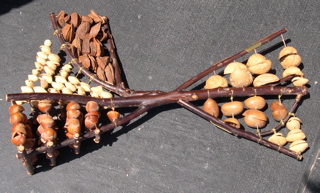
Robert’s multi-nut shaker
NT - Do you find making instruments more challenging than other artistic projects?
Robert - Doing any kind of art has challenges, but making instruments is especially challenging. You never know if it’s going to work the way you envision it or if you’re going to get the sounds you envision. I kind of know what’s going to make a string give you sound and vibrate, but with some of my other things I’m not quite sure until I finish.
I’m really into designing things and spending time in my journal, drawing and getting ideas. Before I actually start working with materials, I’ve usually designed and redesigned and worked out potential problems. And then, I typically will take one of my ideas and break it up into the different concepts that went into it. I’ll make study instruments that just use one aspect of the ultimate goal. Those studies teach me what things are going to work, how they’re going to work or if they’re going to work at all. I may eliminate them. Sometimes the original design doesn’t really take place until a few years later. Then I’ll start recombining the different aspects and wind up with some other instrument. Sometimes those things turn out to be studies for another instrument I intend to make. The Red Thing was a study.
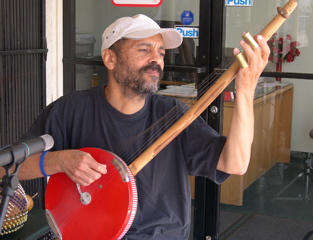
Robert plays “The Red Thing”
This is a coffee can with three split bamboo stakes on it coming up off the bottom of the can and three wire strings emerging from the center of the bottom of the can that go to the end of each of these bows You change the pitches by bending the bows. One of the other main instruments I was playing today has the slide strings like the Red Thing, but it also has bending bow strings, so that’s how my studies got recombined into something a little bit more mature.
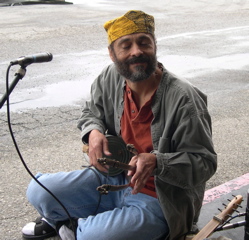 *
*
Robert plays split-bamboo and coffee can instrument
NT - What are your favorite materials to use in making instruments?
Robert - I started out using a lot of hard woods and store bought lumber and making constructed instruments. Then I went to using a lot of actual branches, gourds and natural things. Now I’ve started combining industrial
recycled things with natural things and even some things that are all industrial recycled things with no natural things at all. Lately I’ve fallen in love with the idea of doing things with teapots and metal containers. Even though I’ve only actually completed only one teapot instrument, I’ve got stacks and stacks of teapots at home, 65 to 70 teapots. I buy them every time I go to the thrift store and I go to thrift stores everywhere.
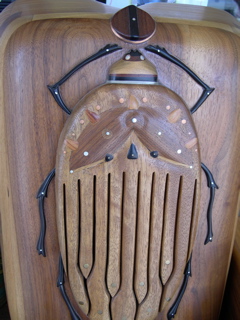
Carved scarab wooden tongue or slit drum
NT - Please describe your teapot horn that you played for us today.
Robert - The teapots are actually there for added resonators. The actual horn is a truncated cone made of aluminum and I have no idea what the original function of it was. It’s a vessel horn. I made a lot of linear horns, which is a long tube of one sort or another. In recent years I’ve been making a lot of vessel flutes and I decided to make a vessel horn. It’s a chamber rather than a long tube. This was my first vessel horn.
The teapots contain springs that vibrate and buzz and rattle when I play it. But the actual inside of the teapot isn’t involved in the air chamber. Just the bases of the teapot that close off each end of this conical chamber. The teapot bases vibrate like the head of a drum. They pick up the frequency that my lips are buzzing and then the teapots own resonance asserts itself and the springs pick up those things. I get a lot of double sounds. Not just the sound of the springs and the note I’m playing, but additional notes that come from the resonance of the teapot.
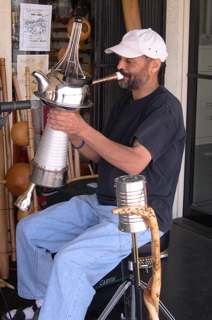 )
)
Robert plays his “Teapot Horn”
NT - Do you get inspiration from folk instruments?
Robert - I have a library of not just invented instruments that interest me. African traditional instruments and Indian traditional instruments especially interest me. I may not try to duplicate those exact things, but I like the concepts that go into them. Like the idea in African music that they always like to have an extra buzz or rattle to something that adds an overlay of sound. So even though my instruments might add completely different kinds of extra sounds, I like to add those things like springs that add an extra element.
NT - Don’t some of your instruments like the cigar box guitar come from early American traditions?
Robert - In the South the sharecroppers didn’t have money to spend on instruments. This is also largely an African tradition to make instruments out of the things that are available. When Africans first were brought here we obviously didn’t bring our instruments with us, but we brought the traditions with us. So the things that were available became the resources for our instruments. The cigar box made a great resonator for people who might have used gourds or other vessels like hollowed out logs in Africa. They’d poke a stick through it and stretch some wire on it.
When I was young, screen doors weren’t made of aluminum or plastic like they are now. They were made with steel wire, so you could unravel the steel wire and get the kinks out. Or you could get bicycle brake cables and untwist them and take the individual strings out to use as strings. Musical strings were just as hard to come by as the actual instruments. It was really an inventive time and an inventive people that came up with those instruments. You even hear about a lot of those old blues musicians and rock and roll players who made their own instruments using resources like the wire from the top of a broom. They’d nail it to the top of their shack and slide a chunk of wood under each side to raise the string up and tune it. Then they’d slide a bottle on there and tap on it with a stick and play some dynamite blues. It’s called a “Diddley Bow.”
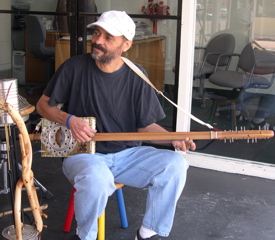
Robert plays his cigar box guitar
NT - Can anyone make home made instruments and what can they make them out of?
Robert - When I’m doing projects with kids I use a lot of tin cans. There’s a Brazilian instrument, actually an African instrument made in Brazil, called a “Berimbau.” It’s a musical bow, but it evolved from the hunting bow and all it has is a gourd resonator tied to it and around the stick and the string. I do the same thing with a tomato can and a piece of PVC tubing. I do that workshop with kids all the time and they’re easy to build. You can tune them, too by putting a ring of wire around the structure of the PVC and the string and slide it down and change the pitch. It’s a string percussion instrument you strike with a stick. That evolved from the bow and the arrow. A hunter walking along would tap on that string and hear the sound, and then when they touched it to a hollow object they discovered resonators, and so stringed instruments basically came from hunters.
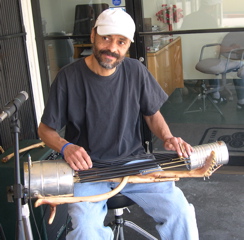
Robert plays his paint can instrument
People who hunted and ate birds mostly developed flutes because birds have hollow bones and when they had those bones in their mouths, eventually someone is going to blow across that hollow bone and discover that anything hollow like that can make a sound. Then they go to reeds and a lot of other things. People developed the spear thrower, a flat stick that the spear hooks in to which gave them more leverage when they threw it. That makes a sound when it goes through the air and led to instruments like the “bull roarer” and things like that. People will always invent ways to provide sustenance and then they’ll adapt those things to provide pleasure. Music is definitely a pleasure.
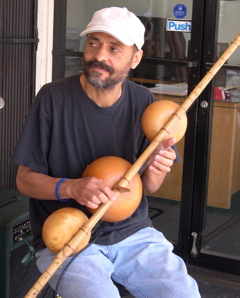
Robert plays stringed instrument made of gourds
<- interview index -

[ home ]